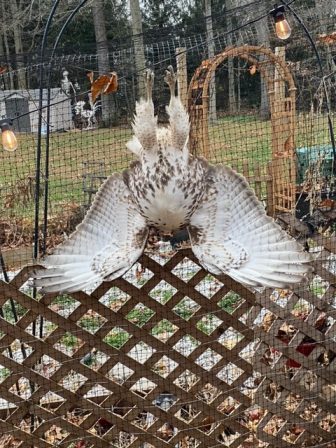Police on Wednesday night freed a red-tailed hawk that had become stuck in a southeastern New Canaan chicken coop.

The trapped hawk in distress. Courtesy of NCPD
Authorities were notified of the problem on Buttery Road at about 3:30 p.m. on Nov. 20, according to Officer Sean Godejohn, head of the New Canaan Police Department’s Animal Control section.
“The hawk presumably flew into the coop to get a chicken and got stuck,” Godejohn said.
The bird was not injured, he said. Godejohn freed the hawk back into the wild after untangling it from the fine chicken wire netting.

New Canaan Animal Control Officer Sean Godejohn freeing the hawk. Courtesy of NCPD
A common sight in New Canaan, “hawks and other birds can easily be caught in netting,” Godejohn told NewCanaanite.com.
“So if you have soccer nets not in use I would advise they be taken down,” he said.
Animal Control regularly helps sick or injured hawks, transporting the predatory birds to a rehabilitation facility as needed.
According to the state Department of Energy and Environmental Protection, birds of prey—typically hawks and owls—often “cause conflicts when they prey on backyard livestock, such as chickens and rabbits.”

The rescued hawk. Courtesy of NCPD
“It is the responsibility of the livestock owners to make sure their animals are kept in secure and sturdy structures that are predator-proof,” according to the state agency. “Many resources are available online from enthusiast groups and cooperative extension services that offer advice and instructions on how to secure backyard livestock from aerial predators, as well as from animals like black bears, foxes, coyotes, bobcats, and raccoons.”
According to the U.S. Fish and Wildlife Service, red-tailed hawks “use open fields and meadows for hunting and tall trees for nesting.”
“They like to live in forests near open areas,” according to the federal agency. “These hawks are active during the day and are adept soarers. These hawks will feed on small rodents, smaller birds, reptiles, and amphibians. They usually locate prey with vision from a high perch and swoop down to capture it in their talons.”
